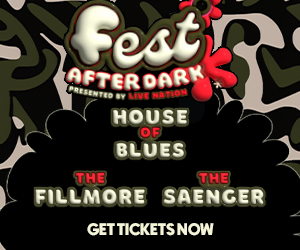The Accidental Darlings—formerly the Violet Era—have two things really going for them: 1) Misty Belmonte has good rock star presence on record and on stage, and 2) you never go wrong with Led Zeppelin as an influence. Belmonte rages and wails on a cinematic scale, as if she’s working out the psychic hoodoo that accompanies watching her family chainsawed into Alpo. Live and on songs like “Candy,” you keep waiting for her to struggle as she sings at what sounds like the top of her range, but she stays dramatic and successfully makes melodies that make you care about, which is the hallmark of a good front person. Even when you suspect songs like “Like a Dog,” “Dreaming of the Endless” and “Horrorshow” have a gothy, exaggerated pain you otherwise wouldn’t care about, Belmonte involves listeners through sheer personality.
The songs also work because guitarist Johnny Hotwheels understands Led Zep’s exotic feel, and his riffs push at unexpected moments giving songs unexpected momentum. Sometimes he sounds like he found Zep through Jane’s Addiction, but that’s not a bad thing because Jane’s hypnotic, mysterious sound perfectly matches the feeling that Belmonte is lost in her inner struggles, whatever they are. Pieces like “Epic” feel like spontaneous expressions and not the rehearsed, crafted performances that they are.
The Accidental Darlings and Music for the Furniture by Amerigo share a Zep influence, but their Zep has more of a dreamy, Jeff Buckley feel. The grooves have a narcotized feel and Matt Martin doesn’t quite have Buckley’s range, but he’s not afraid of the high notes, and one of Amerigo’s signatures has been their use of strings. On “Vertigo,” they’re particularly effective as they swirl then chop, emulating the title sensation first by articulating a circular melody, then by adding a dissonant variation to that melody on the chorus. Obviously, there’s an element of pretension in music like this, but even when the songs don’t entirely work, Amerigo deserves credit for ambition and artistic nerve.
Unfortunately, both bands also share shaky vocal production. Good performances by both Belmonte and Martin are at times hard to hear in both cases because they are either poorly recorded or mixed too low. I’m a fan of the D.I.Y. aesthetic as much as the next guy because I like to hear the music the artists heard in their heads, but ProTools are only as good as the person using them. The sound isn’t so weak that it should chase anyone away, but next to other records, the difference is noticeable, which is a shame.




